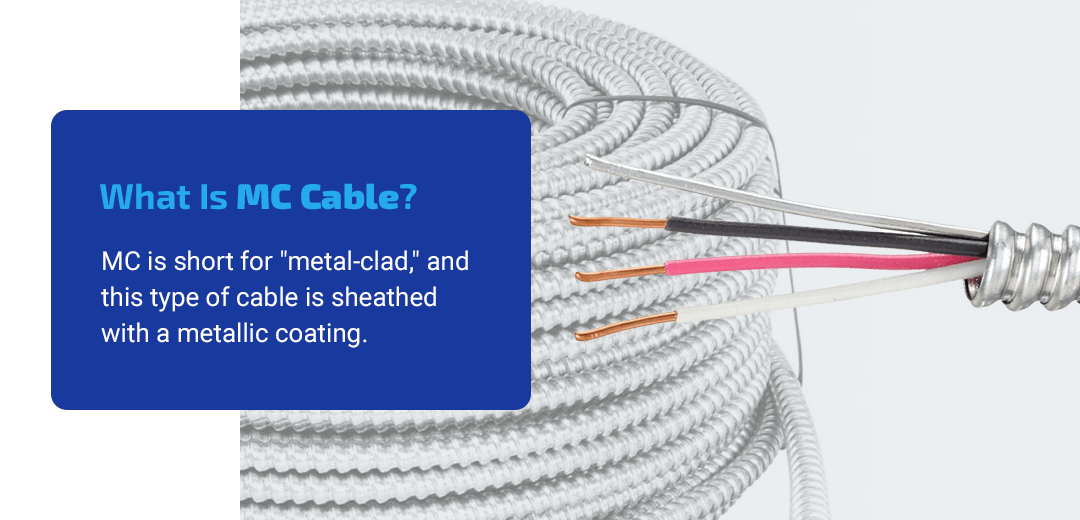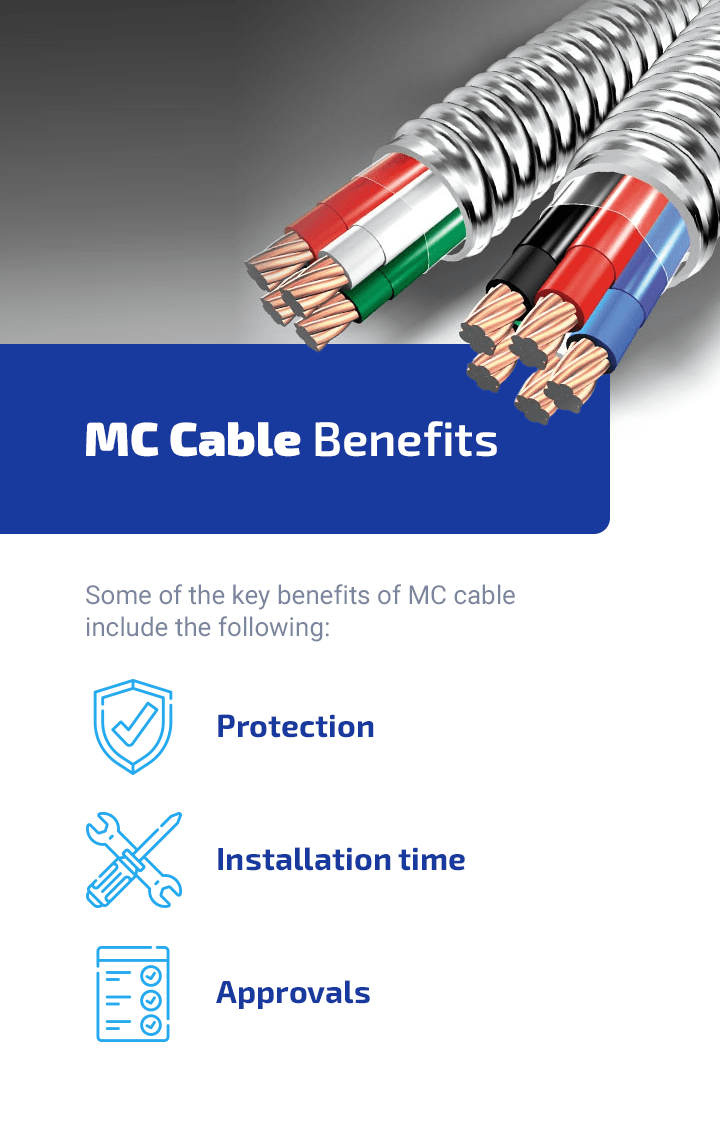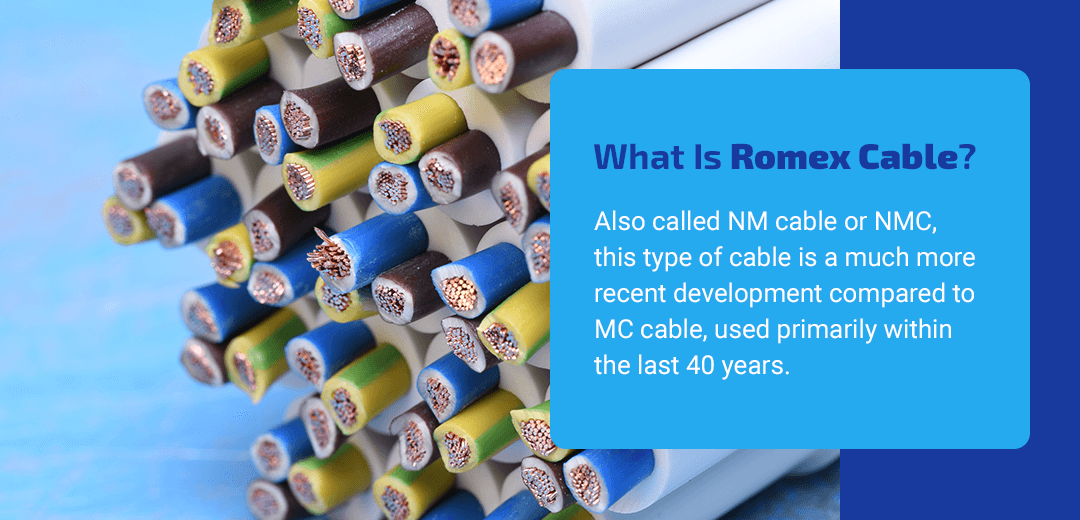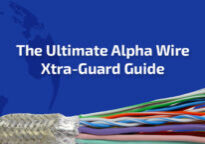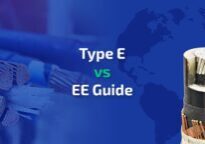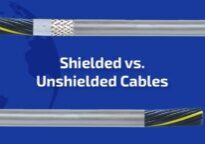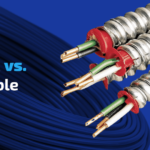
Jul 20, 2021
Romex vs. MC Cable
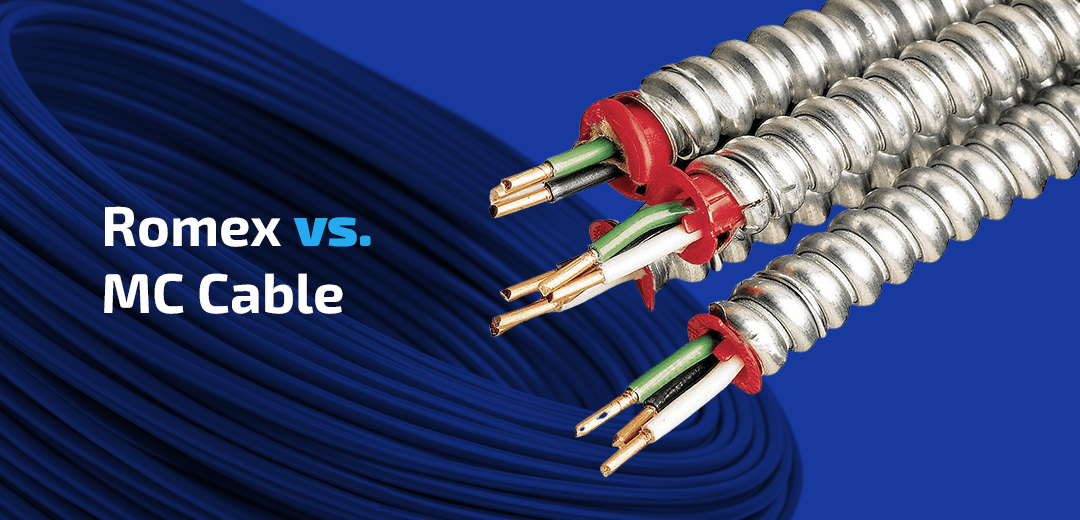
Electrical cable options vary widely, with unique types used in specific applications. Therefore, choosing the right cable type is one of the essential tasks installers must take on before initiating a project. Romex and MC cabling are two types of cables that may be commonly used, especially in residential applications. While both are approved for use in residential applications by National Electrical Code (NEC) regulations, these cables each have unique features to consider for installation.
When exploring Romex vs MC cable differences, it’s crucial to consider factors like usability, safety, and cost-effectiveness. This comparison will guide you through each aspect to help you make an informed decision.
What Is MC Cable?
MC is short for “metal-clad,” and this type of cable is sheathed with a metallic coating. MC cable is defined as an assembly of one or more insulated circuits, often enclosed with an armor of metal tape or a metallic sheath. The most popular MC cables today feature aluminum interlocked armor.
MC cable was originally developed in the early 1900s by Edwin Greenfield. Also called metallic sheathed cable, armored cable (AC) or BX cable, MC cable was one of the first cable types developed for both commercial and residential applications. It is still commonly used today in residential, commercial and industrial building construction. Some of the unique features of MC cable include:
- Sheathing: This cable type is defined by the metal sheathing surrounding the insulated wires. Typically consisting of aluminum, this cable sheath covers the wires in an interlocking configuration, allowing flexibility and coverage.
- Wires: MC cables contain at least three wires—two are conductor wires and one is a ground wire. Of the conductors, one is a hot conductor and the other is a neutral conductor. An MC cable may contain more than one hot conductor.
- Wire coatings: The wires in MC cables are either THNN — which are thermoplastic, high-heat and nylon-jacketed — or THWN-2 wires — which are thermoplastic, high-heat and water-resistant. These coatings insulate wires to make them suitable for various MC cable applications.
- Protection: MC cable is corrosion-resistant and able to handle heat and moisture. It is also built with layers of cable protection, meaning the wires are protected from environmental conditions without conduit installation.
In addition to traditional MC cable, several varieties of MC cable are available to suit the needs of unique applications. One example is MC-HL cable, which is designed for use in hazardous locations and features vapor-tight sheathing.
MC Cable Benefits
MC cable has been a popular option for a wide range of commercial, residential and industrial applications, especially those that are looking for all-in-one, cost-effective options. Some of the MC cable advantages include the following:
- Protection: The aluminum sheath of an MC cable provides excellent strength and protection. Unlike non-metallic alternatives, MC cables provide added protection against piercing and shearing forces. While ill-placed nails or screws can still damage the armor, the interior coatings can protect the interior wiring from most environmental conditions.
- Installation time: In applications where conduit is a necessity, MC cable can save valuable labor hours. In most interior and exterior applications, MC cable provides enough protection to eliminate conduit altogether. This advantage saves significant time by eliminating the conduit installation step.
- Approvals: MC cables are approved by the Institute of Electrical and Electronics Engineers (IEEE) and meet a range of specifications. Those specifications include UL 83, UL 1569, UL 1685, military standard A-A59544 and NEC Codes.
These benefits have made MC cable a popular choice for a wide range of applications, including indoor, outdoor, underground and embedded installations.
What Is Romex Cable?
Romex is the trade name for a type of electrical cable that has non-metallic sheathing. Produced by Southwire, this electrical wire is one of the most common types of wire used in indoor residential applications. Also called NM cable or NMC, this type of cable is a much more recent development compared to MC cable, used primarily within the last 40 years. This wire is also called SIMpull, which is another trademark of Southwire referring to the jacketing used on Romex wires.
The following features define Romex cables:
- Sheathing: Romex cable sheaths are commonly made of flexible but easily penetrated PVC material. Each conductor in the cable is insulated individually, and the bundle of wires is also insulated as a whole, ensuring two layers of protection.
- Wires: Like MC cables, NM cables contain at least two conductor wires and a ground wire. One conductor is a neutral conductor, while the others are hot conductors.
- Protection: The coating for non-metallic cable is designed to be non-conducting but also provides a low level of protection against environmental factors. Romex is rated for temperatures of up to 90 degrees Celsius in dry locations and can handle up to 600 volts.
Like MC cable, Romex is available in multiple varieties for unique applications. Depending on how much power needs to be run, various sizes of Romex wire are available, with the most popular sizes being 14 AWG, 12 AWG, and 10 AWG.
Benefits of Romex Cable
Romex cable is a common choice in many residential installations, especially for branch wiring. Romex NM-B is the type of wire used for these types of applications. Some of the unique benefits of Romex cable include:
- Easy handling: Romex cable is typically required to be run in a protective conduit, with some exceptions. Despite this installation limitation, Romex cable itself is easy to work with — the cable can be ripped by hand or with a simple cable ripper. It is also easy to run through conduit due to its smooth exterior.
- Approvals: Romex wires comply with a range of standards, including UL Standard 719, UL Standard 83, ASTM B-3 and B-8, Federal Specification A-A-59544, NFPA 70, REACH and RoHS.
These features make Romex a useful wire for interior wiring applications. Common examples include interior wall wiring, especially for lighting and appliances.
Differences Between Romex and MC Cable
The primary difference when comparing Romex wire versus MC cable is the sheathing. MC cable has a metal casing, while Romex has a non-metallic sheath. While this is a core distinction between the two cable types, it leads to a range of differences relating to the handling, installation and safety considerations of each type of cable. These differences include the following:
- Ripping: Because of the metal sheath, MC cable is difficult to rip back, requiring a specialized tool. Comparatively, Romex cable is easy to rip back using a typical cable ripper.
- Cutting: The metal sheath of an MC cable means it requires some amount of power to cut. Typically, this is accomplished with a hacksaw or specialized armored cable cutting tool. Romex is comparatively easy to cut using lineman’s pliers or the cutters on wire strippers.
- Handling: Romex cable is light and easy to handle — the smooth coating makes it simple to pull through holes and conduit. MC cable, on the other hand, is a bit heavier, and the corrugated surface of the cable can make it difficult to pull through holes.
- Safety: Compared to Romex, MC cable is safer to install due to its metallic sheath. This sheath helps protect against accidental shearing and penetration, reducing the risk for accidental wire exposure. Romex sheathing is easily penetrated or sheared, making it less safe unless run through protective conduit.
- Environmental protection: While Romex cable can provide some protection against heat, prolonged exposure to moisture and environmental conditions can result in degradation over time. MC cable provides greater protection against the elements and has the added benefit of providing more protection against pests — the metallic casing protects against biting damage from rodents.
- Electric shielding: Both MC cable and Romex are effective at protecting against magnetic fields, but MC cable can provide additional protection against electric fields due to its metallic casing. Non-metallic Romex cables cannot provide the same protection.
- Grounding: MC cable is grounded through its metal armor or through an internal ground wire. If grounded through the metal casing, this casing needs to be attached to metal boxes. Romex is grounded through an internal ground wire since the sheathing is non-conductive.
- Cost: Cost is a tricky difference between Romex and MC Cable. When it comes to pure MC cable versus Romex cost, Romex is about 25% cheaper than MC cable due to the fewer source materials and lower shipping costs. In terms of installation, Romex can cost more than MC cable if a protective conduit is required.
While the NEC accepts both of these cable types, the differences between these cables must be considered to ensure the safety and longevity of an installation.
When to Use MC vs. Romex
The benefits and differences between Romex and MC cables highlight the differing uses of these cables. But how do you choose between one or the other for an application?
Consider these factors when choosing between MC and Romex:
Conduit or No Conduit
Romex can be installed indoors with no conduit in certain applications. However, using MC cable in most situations requiring a conduit is often easier and more cost-effective. MC cable has built-in protection, so it can be run indoors without a conduit.
Indoors or Outdoors
Both Romex and MC cable can be run indoors. If you’re looking for an outdoor installation, your options are more limited. Romex provides limited protection against the elements and damage, so it should never be used outside. One alternative is an underground feeder (UF-B) cable, which is similar to Romex but offers more protection for outdoor and underground applications so it can be run without a conduit. Otherwise, you can choose MC cable, which provides sufficient protection and function in outdoor and indoor applications.
Above Ground or Underground
Romex should never be installed underground — the only NM cable that can be installed in this way is a UF-B cable. MC cable can be installed underground as long as it is run through a conduit to prevent decay. For above-ground applications, MC cable can be installed without a conduit.
Enclosed or Open
For indoor applications, Romex must be installed in an enclosed space. You might install it within a wall, inside a ceiling or under a floor. Depending on the application’s needs, this may be done with or without conduit. However, the Romex wire must be run through a conduit if the installation is out in the open. MC conduit does not require these considerations and can be installed in enclosed or open spaces.
In addition to these considerations, make sure you comply with the NEC first before you initiate a wiring project. Looking to those codes can help guide your choice in wiring and save you trouble in the long run.
Wesbell MC and Romex Options
If you’re looking for MC Cable or Romex for your next installation, Wesbell has what you need.
We carry a wide range of Romex wire, all sourced from the most reliable manufacturers in the industry. We buy from manufacturers like Southwire, meaning we sell quality products directly from the source. We are also able to provide these products at the lowest price. Our offerings include popular sizes like 14 AWG, 12 AWG and 10 AWG, but we carry everything up to 2 AWG. All of our wires are color-coded according to size, but you can also request specific colors for orders of 50,000 feet or more.
As for our copper MC cable offerings, Wesbell Electronics offers a range of sizes and configurations to meet the needs of practically any application. We stock copper MC Cable AWG sizes 14 through 2. Each size comes with two to four conductors and an additional ground wire. We also carry cables made of solid, stranded and bare copper to meet unique application needs.
With any of our cable offerings, you can purchase by the foot to get any length of cable you need for your project.
Work With Wesbell
For over 30 years, Wesbell has been dedicated to providing quality bulk wire, cable and tubing products. We offer high-quality Romex wire and copper MC cables in various sizes and configurations to meet your unique needs. We can also save you time with assembly and processing services, including cutting, stripping and twisting. We’re an ISO 9001:2015 and ISO 13485:2016 certified company featuring team of expert technicians. You can trust Wesbell to provide the quality products and services you need to save time and money on your next project.
Browse our products to learn more about our Romex and MC cable options, or contact us today!

